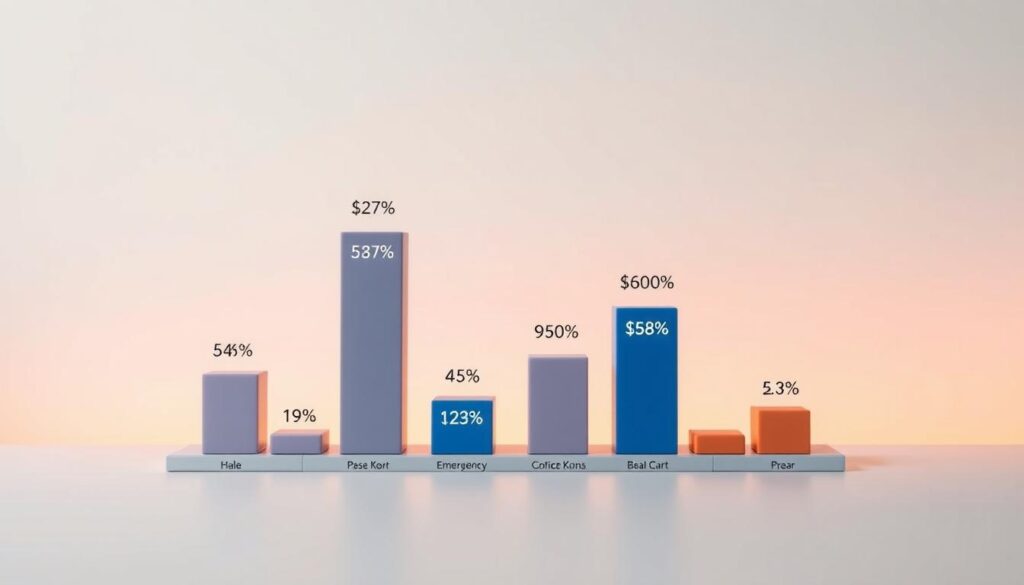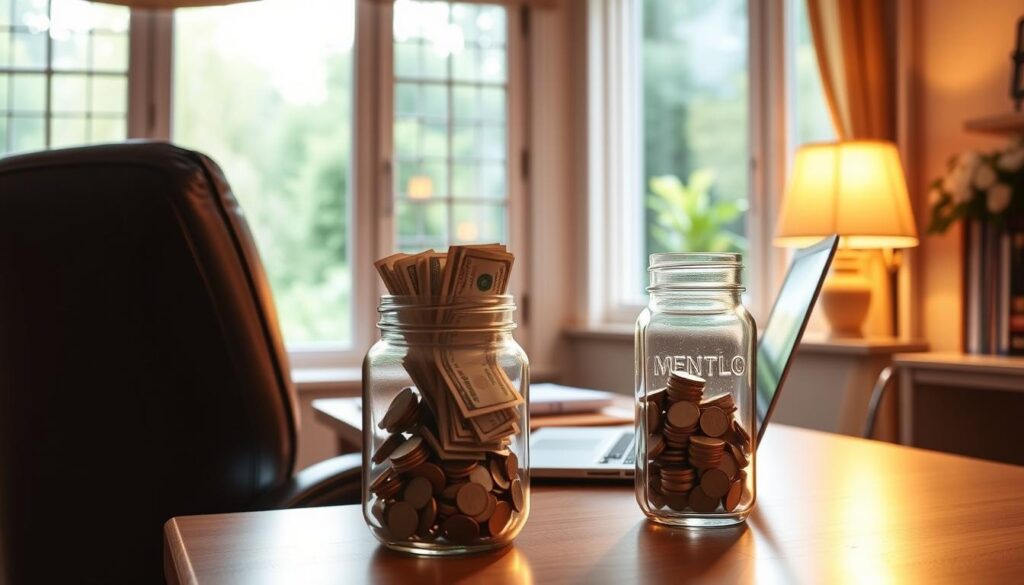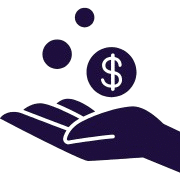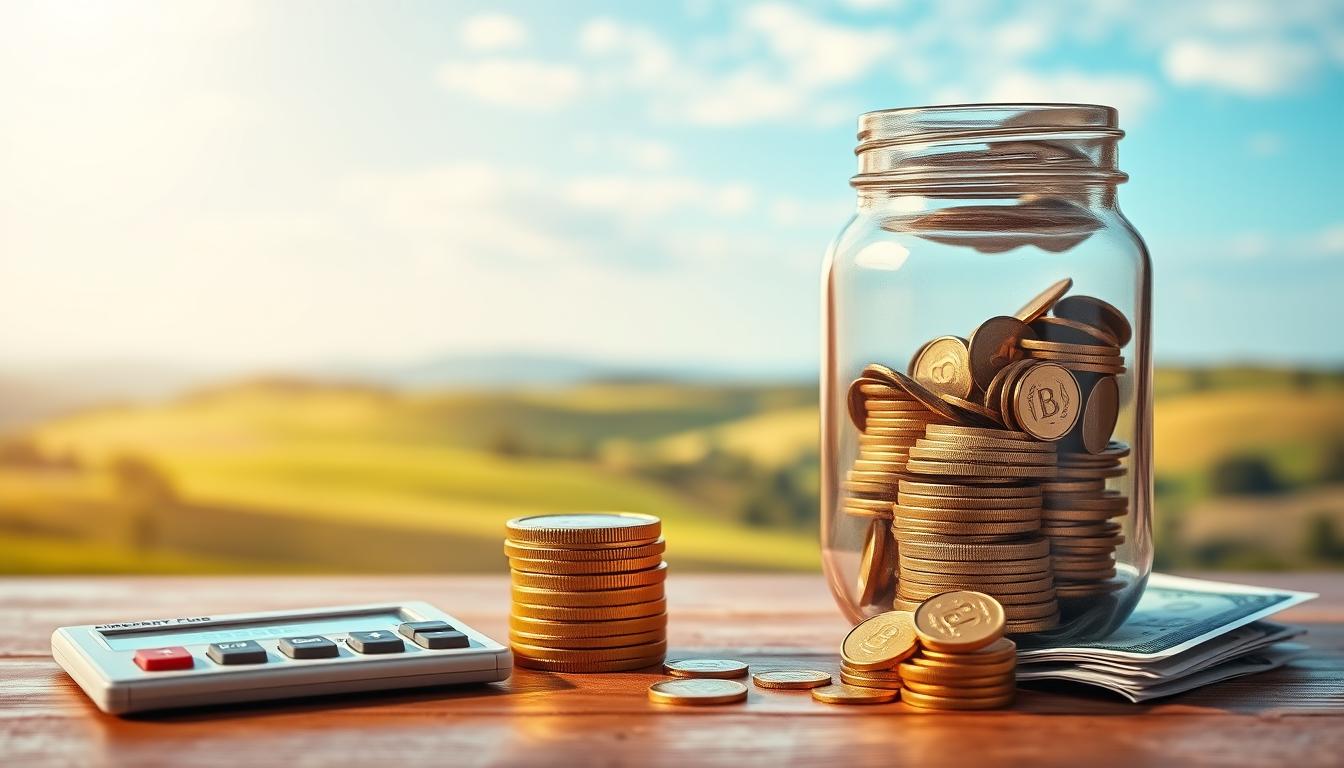Building a safety net is a crucial aspect of financial planning. Life is unpredictable, and unexpected expenses can arise at any moment. Having a cushion of emergency savings can help you navigate financial shocks, such as car repairs or medical bills, without going into debt.
An emergency fund provides peace of mind and financial stability. It’s essential to determine the right amount to save, considering your income, expenses, and financial goals.
Key Takeaways
- Having an emergency fund is crucial for financial stability.
- Determine your savings goal based on income, expenses, and financial goals.
- A well-planned emergency fund can help you navigate financial shocks.
- Savings can provide peace of mind and financial security.
- Financial planning is essential for building a safety net.
The Financial Safety Net Everyone Needs
Life is full of unexpected expenses, making a financial safety net indispensable. An emergency fund serves as a buffer against financial shocks, providing peace of mind and financial stability.
Definition and Purpose of Emergency Funds
An emergency fund is a pool of money set aside to cover unexpected expenses, such as car repairs, medical bills, or losing a job. Its primary purpose is to prevent going into debt when unexpected expenses arise. Having such a fund is considered a fundamental aspect of personal finance management.

Statistics on Financial Emergencies in America
Financial emergencies are more common than many might think. Here are some key statistics:
- Approximately 40% of Americans don’t have enough savings to cover a $400 emergency expense.
- Nearly 1 in 5 Americans have had to use a credit card or take out a loan to cover an unexpected expense.
- Medical bills are a leading cause of financial emergencies, with over 60% of bankruptcies in the U.S. attributed to medical expenses.
These statistics underscore the importance of having a financial safety net. By understanding the risks and being prepared, individuals can better navigate financial uncertainties.
The True Cost of Being Financially Unprepared
Financial unpreparedness is a ticking time bomb waiting to disrupt your financial security. Without an emergency fund, individuals are exposed to various financial risks that can have long-lasting impacts.

Common Unexpected Expenses
Unexpected expenses can arise from various sources, including:
- Car repairs
- Medical emergencies
- Home maintenance issues
- Loss of income due to job loss or illness
The Domino Effect of Financial Emergencies
The domino effect of financial emergencies can significantly increase the financial emergencies cost. When one financial issue arises, it can trigger a cascade of other problems, such as:
- Increased debt
- Reduced credit scores
- Less access to future credit
The Hidden Costs of Using Credit for Emergencies
Using credit for emergencies due to financial unpreparedness can lead to hidden costs, including high-interest rates and fees. This can result in a cycle of debt that’s challenging to overcome.
Understanding these risks highlights the importance of having an emergency fund to mitigate the cost of financial emergencies.
Emergency Fund: How Much Should You Save?
Understanding how much to save for emergencies can be challenging without a clear guideline. The traditional rule of thumb is to save enough to cover several months of living expenses.
The Traditional 3-6 Month Rule
Financial experts often recommend saving 3 to 6 months’ worth of expenses in an easily accessible savings account. This guideline provides a cushion in case of unexpected events like job loss, medical emergencies, or car repairs.
Calculating Your Essential Monthly Expenses
To determine your emergency fund amount, start by calculating your essential monthly expenses. These include:
- Rent or mortgage
- Utilities
- Groceries
- Transportation costs
- Minimum debt payments
- Insurance premiums
| Expense Category | Monthly Cost |
|---|---|
| Rent/Mortgage | $1,500 |
| Utilities | $150 |
| Groceries | $500 |
| Transportation | $300 |
| Debt Payments | $200 |
| Insurance | $100 |
| Total | $2,750 |
Adjusting Recommendations to Your Situation
The 3-6 month rule is just a starting point. You may need to adjust it based on your job stability, health, and other factors. For example, if you have a volatile income or significant medical expenses, you may want to save more.

By understanding your expenses and adjusting the traditional guideline to fit your needs, you can create a more effective emergency fund that provides peace of mind and financial security.
Factors That Influence Your Emergency Fund Size
Several personal and financial factors influence how much you should save in your emergency fund. Understanding these variables can help you determine the right savings amount for your situation.
Job Stability and Income Predictability
Your job stability and income predictability play a significant role in determining your emergency fund size. If you have a stable job with a regular income, you might need a smaller emergency fund compared to someone with a volatile income or who is self-employed. Consider the likelihood of job loss, fluctuations in income, and the availability of other financial resources.
Family Size and Dependents
The number of dependents you have directly impacts your emergency fund needs. Larger families require more financial resources to cover essential expenses. If you have children or other dependents, you’ll want to save more to ensure their needs are met during financial emergencies.
Health Considerations and Insurance Coverage
Your health and insurance coverage are crucial factors. If you or a family member has ongoing medical needs or you’re concerned about potential health-related expenses, you’ll want a larger emergency fund. Even with insurance, out-of-pocket costs can be significant.
Housing Costs and Geographic Location
Housing costs vary significantly by location and can greatly impact your emergency fund requirements. Areas with a high cost of living may necessitate a larger fund to cover rent or mortgage payments, utilities, and other housing-related expenses during a financial crisis.
Starting Small: The Beginner’s Emergency Fund
The journey to financial security starts with a single step: creating a beginner’s emergency fund. For many, the idea of saving for emergencies can be overwhelming, but it doesn’t have to be. By starting small and setting achievable goals, individuals can build a safety net that provides peace of mind and financial stability.
Setting a $1,000 Initial Goal
One effective strategy for starting an emergency fund is to set an initial goal of saving $1,000. This amount can cover many common emergencies and serves as a foundation for further savings. To achieve this goal, consider breaking it down into smaller, manageable targets.
Building Momentum with Small Wins
Achieving small milestones along the way can help build momentum. For example, setting aside $100 per month for 10 months can reach the $1,000 goal. Celebrating these small wins can motivate individuals to continue their savings efforts.
Psychological Benefits of Having Even a Small Safety Net
Having even a small emergency fund can significantly reduce financial stress and anxiety. It provides a sense of security, knowing that there’s a financial cushion to fall back on in case of unexpected expenses. This psychological boost can be a powerful motivator to continue saving.
By starting small and being consistent, individuals can create a robust emergency fund that supports their long-term financial health.
Practical Strategies to Build Your Emergency Fund
A well-stocked emergency fund can be a lifesaver during unexpected financial crises. Building such a fund requires a combination of discipline, strategy, and a bit of creativity.
Finding Money in Your Current Budget
The first step in building an emergency fund is to identify potential sources of savings within your current budget. This involves scrutinizing your monthly expenses to pinpoint areas where you can cut back. Consider reducing discretionary spending on dining out, subscription services you don’t use, or entertainment.
Budgeting Tips:
- Create a detailed budget to track your income and expenses.
- Prioritize essential expenses over discretionary spending.
- Use the 50/30/20 rule: 50% for necessities, 30% for discretionary spending, and 20% for saving and debt repayment.
Automating Your Savings Process
Automating your savings can make building an emergency fund easier and less prone to being neglected. Set up automatic transfers from your checking account to your savings or emergency fund account.
Automation Tips:
- Set up recurring transfers on payday to ensure consistent saving.
- Use direct deposit for a portion of your paycheck into your savings account.
Using Windfalls and Tax Refunds Strategically
Windfalls, such as tax refunds or bonuses, can significantly boost your emergency fund. Consider allocating a portion or all of these windfalls towards your savings.
| Windfall Source | Potential Amount | Suggested Allocation |
|---|---|---|
| Tax Refund | $1,000 – $3,000 | 50% – 100% |
| Bonus | $500 – $5,000 | 25% – 50% |
Side Hustles for Accelerated Savings
Engaging in a side hustle can provide an additional income stream that can be directed towards your emergency fund. Popular side hustles include freelancing, tutoring, or selling handmade goods.
Side Hustle Ideas:
- Freelance writing or graphic design.
- Online tutoring or teaching.
- Selling products on e-commerce platforms.
By implementing these strategies, you can steadily build a robust emergency fund that will provide financial security and peace of mind.
Where to Keep Your Emergency Fund
The key to a successful emergency fund lies not just in how much you save, but where you keep it. Your emergency fund’s location can significantly impact its effectiveness in times of need.
High-Yield Savings Accounts
One of the most popular options for emergency funds is a high-yield savings account. These accounts offer a higher interest rate compared to traditional savings accounts, allowing your emergency fund to grow over time. They are also typically liquid, meaning you can access your money when needed.
Money Market Accounts
Money market accounts are another viable option. They often come with debit cards or checks, making it easy to access your funds. These accounts may offer competitive interest rates and the ability to earn interest on your emergency savings.
Certificates of Deposit (CDs) Laddering
For those who want to earn higher interest rates, CDs Laddering can be a strategy. This involves dividing your emergency fund into multiple CDs with different maturity dates. While this method can provide higher returns, it may reduce immediate liquidity.
Accessibility vs. Growth Considerations
When deciding where to keep your emergency fund, it’s crucial to balance accessibility and growth. Your emergency fund should be easily accessible in case of an emergency, but it’s also beneficial to earn some interest on it. Weighing these considerations will help you choose the best option for your financial situation.
In conclusion, the right place for your emergency fund depends on your individual needs and financial goals. By considering options like high-yield savings accounts, money market accounts, and CDs Laddering, you can make an informed decision that balances accessibility and growth.
Common Emergency Fund Mistakes to Avoid
Building an emergency fund is a crucial step in securing your financial future, but it’s easy to make mistakes along the way. Many people make avoidable errors that can significantly impact the effectiveness of their emergency fund.
Keeping Funds in Checking Accounts
One common mistake is keeping your emergency fund in a checking account. While checking accounts offer easy access to your money, they typically earn little to no interest. This means your emergency fund isn’t growing, and inflation might even be eroding its purchasing power over time. Consider a high-yield savings account instead, which can provide a higher interest rate while still allowing you to access your funds when needed.
Investing Emergency Money in Volatile Assets
Another mistake is investing your emergency fund in volatile assets like stocks or cryptocurrencies. While these investments can offer high returns, they’re not suitable for emergency funds because their value can fluctuate significantly. In a financial emergency, you might need to withdraw your money when the market is down, resulting in losses. It’s better to keep your emergency fund in a stable, liquid account.
Setting Unrealistic Savings Goals
Setting unrealistic savings goals can lead to frustration and abandonment of your emergency fund. Instead of aiming for an arbitrary amount, calculate your essential expenses and aim to save 3-6 months’ worth. This approach makes your goal more tangible and achievable.
Forgetting to Adjust as Life Changes
Finally, many people forget to adjust their emergency fund as their life circumstances change. For example, having children, switching jobs, or moving to a new location can all impact your expenses and income stability. Regularly review and adjust your emergency fund to ensure it remains aligned with your current situation.
When to Use Your Emergency Fund (and When Not To)
Understanding when to use your emergency fund is crucial for maintaining financial stability. It’s designed to cover unexpected expenses that can derail your financial plans.
Legitimate Emergency Situations
Certain situations clearly warrant using your emergency fund. These include:
- Medical emergencies: Unexpected hospital visits, surgeries, or chronic condition management.
- Car repairs: If your vehicle is essential for daily commute or work and breaks down.
- Home emergencies: Issues like a burst pipe or necessary repairs to maintain a safe living environment.
Gray Area Expenses
Sometimes, expenses can be tricky to categorize. For instance:
- Car maintenance: While regular maintenance is not an emergency, unexpected necessary repairs might be.
- Home maintenance: Similar to car maintenance, urgent repairs can be considered emergencies.
It’s essential to evaluate whether the expense is truly urgent or can be planned for.
Non-Emergency Expenses to Avoid Tapping Into
Using your emergency fund for non-essential expenses can deplete your financial safety net. Avoid using it for:
- Vacations or luxury items
- Upgrading gadgets or other discretionary spending
Decision Framework for Using Your Fund
To decide whether to use your emergency fund, ask yourself:
“Is this expense urgent, necessary, and unforeseen? Can I afford it without going into debt?”
If the answer is yes, it might be a legitimate use of your emergency fund.
By being mindful of when to use your emergency fund, you can ensure it remains a viable financial safety net when you truly need it.
Rebuilding After Using Your Emergency Fund
After an emergency, getting your financial safety net back in place is a top priority. Rebuilding your emergency fund is crucial for maintaining financial stability and being prepared for future unexpected expenses.
Creating a Replenishment Plan
The first step in rebuilding your emergency fund is to create a replenishment plan. This involves determining how much you need to replenish and setting a realistic timeline to achieve this goal. Consider automating your savings by setting up regular transfers from your checking account to your savings or emergency fund account.
Adjusting Your Budget Temporarily
To accelerate the replenishment process, you may need to make temporary adjustments to your budget. Identify areas where you can cut back on non-essential spending and allocate those funds towards rebuilding your emergency fund. Even small adjustments can make a significant difference over time.
For instance, you could reduce dining out, cancel subscription services you don’t use, or find ways to lower your household expenses. Here’s a simple example of how you might allocate your budget adjustments:
| Area | Original Spend | Adjusted Spend | Savings |
|---|---|---|---|
| Dining Out | $300/month | $150/month | $150/month |
| Subscription Services | $100/month | $50/month | $50/month |
| Household Expenses | $500/month | $400/month | $100/month |
Learning from the Emergency Experience
Using your emergency fund can be a valuable learning experience. It provides an opportunity to review what triggered the emergency and how you can potentially prevent or mitigate similar situations in the future. Reflecting on the experience can help you make more informed financial decisions and improve your overall financial resilience.
Emergency Funds for Different Life Stages
Emergency funds are not one-size-fits-all; they need to be tailored according to the financial responsibilities and risks associated with different life stages. As people’s financial obligations and income stability change over time, so too should their emergency savings strategies.
Young Adults and New Graduates
For young adults and new graduates, the focus should be on building an initial emergency fund to cover unexpected expenses like car repairs or medical bills. Starting with a smaller goal, such as $1,000, can be more achievable.
Families with Children
Families with children need to consider additional expenses such as childcare and education costs when determining their emergency fund size. A larger fund can provide a cushion against the financial shocks associated with family responsibilities.
Pre-Retirement Planning
As individuals approach retirement, their income sources may change, and their emergency fund needs may shift. Ensuring that savings are easily accessible and considering the potential for healthcare costs is crucial.
Retirees’ Emergency Considerations
For retirees, emergency funds should be focused on covering potential healthcare expenses and other retirement-related costs. The size of the fund may need to be adjusted based on retirement income sources and expenses.
By tailoring emergency fund strategies to different life stages, individuals can better prepare for financial shocks and ensure a more stable financial future.
Special Considerations for Self-Employed and Gig Workers
For self-employed individuals and gig workers, creating a financial safety net requires careful consideration due to the inherent income volatility in their work arrangements. Unlike traditional employees, their income can fluctuate significantly from month to month, making it challenging to predict and plan for the future.
Dealing with Income Volatility
One of the primary challenges faced by self-employed individuals and gig workers is managing their finances during periods of low income. To mitigate this, it’s essential to:
- Track your income closely to anticipate and prepare for slow periods.
- Diversify your income streams to reduce dependence on a single client or project.
- Adjust your expenses according to your current financial situation.
Business vs. Personal Emergency Funds
Self-employed individuals often blur the lines between personal and business finances. However, it’s crucial to maintain separate emergency funds for business and personal use. This separation helps in managing business-related expenses during slow periods without compromising personal financial stability.
Tax Planning and Emergency Savings
Tax planning is another critical aspect for the self-employed. Since their income isn’t subject to tax withholding, they must plan for tax payments. A strategy could be to:
- Set aside a portion of income for taxes in a separate savings account.
- Consider consulting a tax professional to optimize tax strategies and potentially reduce tax liabilities.
By addressing these unique challenges, self-employed individuals and gig workers can better secure their financial futures despite the uncertainties of their income.
Emergency Funds During Economic Uncertainty
A strong emergency fund serves as a financial bulwark against the uncertainties of economic fluctuations. During times of economic instability, the importance of having a robust financial safety net cannot be overstated.
Recession-Proofing Your Finances
Recession-proofing your finances involves more than just saving; it’s about creating a financial ecosystem that can withstand economic downturns. Key strategies include diversifying your income sources, reducing debt, and maintaining a readily accessible savings fund.
Inflation’s Impact on Emergency Savings
Inflation can erode the purchasing power of your emergency fund over time. To mitigate this effect, consider keeping a portion of your emergency savings in high-yield savings accounts or inflation-protected securities.
Balancing Liquidity and Purchasing Power
Striking a balance between liquidity and purchasing power is crucial. While it’s essential to keep your emergency fund liquid, you should also consider the long-term value of your savings. The following table illustrates potential strategies:
| Strategy | Liquidity | Potential Return |
|---|---|---|
| High-Yield Savings Account | High | 2.0% – 2.5% |
| Short-Term CDs | Medium | 2.5% – 3.5% |
| Inflation-Protected Securities | Low | Variable, tied to inflation rate |
By understanding the impact of economic uncertainty on your emergency fund and implementing strategies to recession-proof your finances, you can better protect your financial stability.
Conclusion
Creating an emergency fund is a crucial step in securing your financial future. As discussed, the size of this fund varies based on factors like job stability, family size, and health considerations. A well-managed emergency fund acts as a buffer against life’s uncertainties, providing peace of mind and financial stability.
To recap, determining the right amount for your emergency fund involves calculating essential monthly expenses and considering personal circumstances. Strategies like automating savings, using high-yield savings accounts, and avoiding common mistakes can help you build and maintain your fund. By prioritizing your emergency fund, you’re taking a proactive approach to financial planning.
This financial planning summary highlights the importance of being prepared for unexpected expenses. By following the guidelines outlined, you can create a robust emergency fund that safeguards your financial well-being, leading to a more secure financial future. This concludes our exploration of emergency funds, providing a comprehensive emergency fund conclusion.
FAQ
What is a good amount to save in an emergency fund?
The traditional guideline is to save 3-6 months’ worth of essential expenses, but this can vary based on individual circumstances such as job stability, family size, and health considerations.
Where should I keep my emergency fund?
Consider keeping your emergency fund in a high-yield savings account or money market account, as these options provide a balance between accessibility and growth.
How can I start building an emergency fund if I’m on a tight budget?
Start by setting a manageable goal, such as saving
FAQ
What is a good amount to save in an emergency fund?
The traditional guideline is to save 3-6 months’ worth of essential expenses, but this can vary based on individual circumstances such as job stability, family size, and health considerations.
Where should I keep my emergency fund?
Consider keeping your emergency fund in a high-yield savings account or money market account, as these options provide a balance between accessibility and growth.
How can I start building an emergency fund if I’m on a tight budget?
Start by setting a manageable goal, such as saving $1,000, and automate your savings process to build momentum.
What are some common mistakes to avoid when creating an emergency fund?
Avoid keeping your emergency fund in a low-interest checking account, investing it in volatile assets, setting unrealistic savings goals, and forgetting to adjust your fund as your life circumstances change.
When should I use my emergency fund?
Use your emergency fund for legitimate emergency situations such as car repairs, medical bills, or losing your job, but avoid using it for non-essential expenses.
How do I replenish my emergency fund after using it?
Create a replenishment plan, temporarily adjust your budget, and prioritize rebuilding your emergency fund to its original level.
Are emergency funds relevant for retirees?
Yes, retirees still need emergency funds to cover unexpected expenses, and their emergency fund needs may be influenced by factors such as health considerations and housing costs.
How do economic conditions like recession or inflation affect my emergency fund?
During economic uncertainty, consider recession-proofing your finances, and be mindful of inflation’s impact on your emergency savings, balancing liquidity and purchasing power.
What are some strategies for self-employed individuals to manage their emergency fund?
Self-employed individuals should consider dealing with income volatility, separating business and personal emergency funds, and incorporating tax planning into their emergency savings strategy.
,000, and automate your savings process to build momentum.
What are some common mistakes to avoid when creating an emergency fund?
Avoid keeping your emergency fund in a low-interest checking account, investing it in volatile assets, setting unrealistic savings goals, and forgetting to adjust your fund as your life circumstances change.
When should I use my emergency fund?
Use your emergency fund for legitimate emergency situations such as car repairs, medical bills, or losing your job, but avoid using it for non-essential expenses.
How do I replenish my emergency fund after using it?
Create a replenishment plan, temporarily adjust your budget, and prioritize rebuilding your emergency fund to its original level.
Are emergency funds relevant for retirees?
Yes, retirees still need emergency funds to cover unexpected expenses, and their emergency fund needs may be influenced by factors such as health considerations and housing costs.
How do economic conditions like recession or inflation affect my emergency fund?
During economic uncertainty, consider recession-proofing your finances, and be mindful of inflation’s impact on your emergency savings, balancing liquidity and purchasing power.
What are some strategies for self-employed individuals to manage their emergency fund?
Self-employed individuals should consider dealing with income volatility, separating business and personal emergency funds, and incorporating tax planning into their emergency savings strategy.


[…] an era of economic uncertainty and rapid change, taking control of your financial future has never been more critical. While the […]